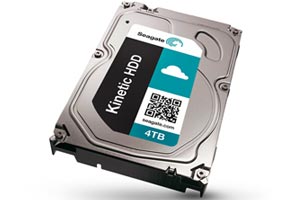

Seagate Technology has unveiled its revolutionary, new object-based storage drive - the Seagate Kinetic HDD. Based on the Seagate Kinetic Open Storage platform, Kinetic HDD dramatically reduces total cost of ownership (TCO) by combining an open-source object storage protocol with Ethernet connectivity to eliminate multiple layers of legacy software and hardware infrastructure, greatly simplifying cloud storage architectures.
Introduced in 2013, the Seagate Kinetic Open Storage platform has garnered broad industry support from cloud and enterprise customers, as well as software and hardware systems partners, including AOL, Digital Sense, and Hewlett-Packard, which have collaborated to support the open Kinetic API and helped to enable this new storage technology to come to market.
“Over the past decade, the unprecedented explosion of data has been driven by social media, smartphones, tablets, and the rapid growth of every sort of Internet-connected device,” said Scott Horn, Seagate Vice-President of Marketing. “Cloud service providers (CSPs) are increasingly looking for solutions that will simplify infrastructure, improve scalability and reduce costs – Kinetic HDD addresses these needs revolutionizing the data storage economics for today’s cloud and beyond.”
The Kinetic Open Storage platform dramatically simplifies large-scale storage architectures by eliminating the overhead of an entire storage server tier, which, in turn, lowers equipment costs. Fewer number of storage servers also reduces power consumption and headcount expenses associated with managing storage, resulting in lower operating costs, for a combined savings of up to 50 per cent.
The Kinetic Open Storage platform improves drive and rack level performance by eliminating the need for legacy file systems and shifting HDD storage media space management to the drive itself. It delivers a streamlined architecture allowing storage applications to talk directly to Kinetic object storage HDDs. Performance is further enhanced by eliminating storage server bottlenecks via direct IP addressing of each drive, thereby improving system level throughput.
See What’s Next in Tech With the Fast Forward Newsletter
Tweets From @varindiamag
Nothing to see here - yet
When they Tweet, their Tweets will show up here.





























